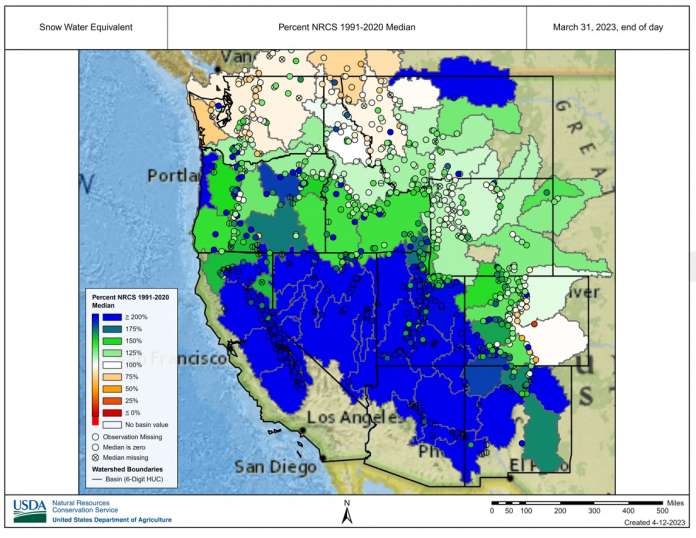Above: Western United States Snow Water Equivalent (SWE) map, ending March 31, 2023, image by NRCS.
Wyoming has had a particularly harsh winter. Central Wyoming recorded a 151 day stretch without temperatures reaching 50℉ or higher, the longest such period on record, breaking the previous record of 128 days straight below 50℉ by a wide margin.
For Wyoming as a whole, November through March, the state’s average temperature was 2.5℉ below normal.
The heavy amount of snow on the ground is part of the reason for the sustained cold, Noah Myers with the National Weather Service office in Riverton told Cowboy State Daily.
“We had a lot of snow on the ground,” Myers said. “We still do have quite a bit of snow in the Wind River Basin, and the snow helps keep that cold in.”
In fact, the amount of snow that fell and accumulated in Wyoming and other western states this winter season set new records, according to satellite imagery.
Cowboy State Daily meteorologist Don Day reports that, in 23 years of snow extent tracking using satellite imagery, 2022’s 444,000 square miles of snow and ice coverage in the Western states is the most snow coverage that has remained over the region at the end of March. The snow extent in 2023 is nearly double the 242,000 square mile snow extent average recorded for Western States on March 31 for the past 22 years.
“As of March 31, it’s the most amount of snow cover in the United States since they’ve been tracking snow cover with satellites starting in 2001,” Day said. “The snow-covered area for the Western states was 184% of average for March, the highest since the satellite record began in 2001.”
Snow coverage on March 31 exceeded 100 percent of average for Arizona, California, Colorado, Idaho, Montana, Nebraska, Nevada, New Mexico, Oregon, South Dakota, Utah, Washington state, and Wyoming. Arizona, Montana, Nebraska, Nevada, New Mexico, and South Dakota, each exceeded 200 percent of their normal snow extent for the last of March, with South Dakota, Nebraska, and Arizona, at more than 350 percent their normal snow extent, having the broadest remaining snow coverage.
Wyoming’s end of March snow coverage was more than 190 percent of the average.
“You can have really snowy years, but by the end of March, you’ve lost a lot of the snow,” Day said. “But not this year, since it’s been such a cold winter and spring over most of the northern and western United States.”


